Viconics Electronics VTR WIRELESS THERMOSTAT/DATA TERMINAL User Manual
Viconics Electronics Inc. WIRELESS THERMOSTAT/DATA TERMINAL Users Manual
Users Manual
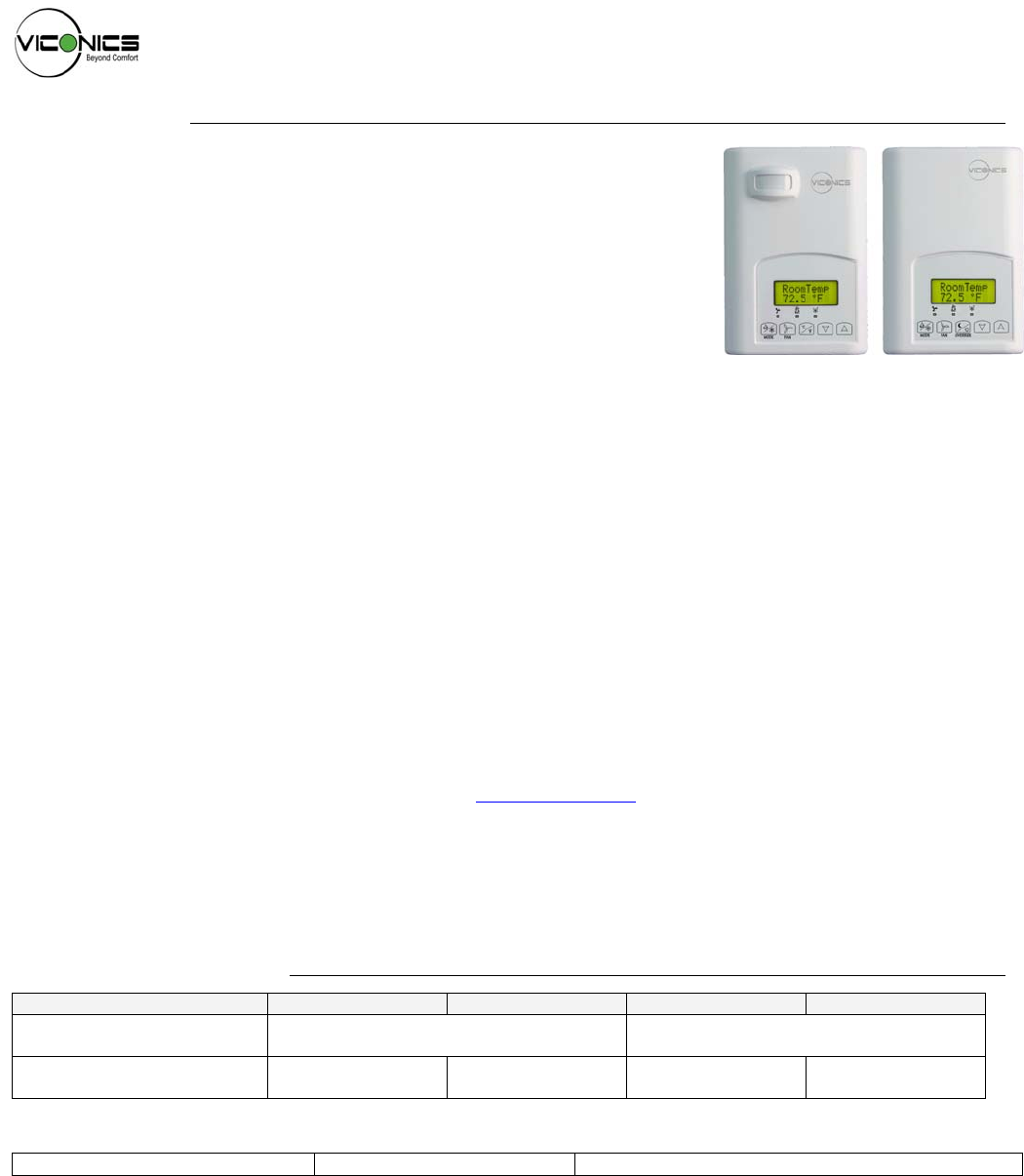
PIR Ready VTR7300 Series
Terminal Equipment Controllers
For Commercial and Lodging HVAC Fan Coil Applications
(Issue Date: March 29, 2010 – 028-0298_R0)
Product overview
The VTR73XX Series Fan Coil Terminal Equipment Controller used in conjunction with
the VC3000 Series Line Voltage Switching Relay Packs is specifically designed for fan
coil control applications. They can be used both for new or retrofit applications. In
retrofit applications, they can re-use the existing wires between the old line voltage
switching thermostat and the fan coil thus saving on the installation of any new wires.
Stand-alone and network operation are available.
The VTR73XX Series Fan Coil Terminal Equipment Controller features a backlit LCD
display with dedicated function menu buttons for simple operation. Accurate
temperature control is achieved due to the product’s PI proportional control algorithm,
which virtually eliminates temperature offset associated with traditional, differential-
based Terminal Equipment Controllers. All models feature configurable System and
Fan button functions to meet all possible applications The VTR73XX Terminal
Equipment Controllers are powered and communicate with the associated VC3000 Series Transformer Relay Pack(s) using
only 3 wires.
2 types of interfaces for the user can be ordered. The VC73x5 models are typically used for hotel and lodging applications
where the middle button of the interface is for the user to select the local displayed scale in ºF or ºC. The VC73x0 models are
typically used for commercial and institution applications where the middle button of the interface is defined for the local
unoccupied override function.
The VTR73XX Terminal Equipment Controllers are also compatible with the new Viconics PIR cover accessories. Terminal
Equipment Controllers equipped with a PIR cover provide advanced active occupancy logic, which will automatically switch
occupancy levels from Occupied to Stand-By and Unoccupied as required by local activity being present or not. This advanced
occupancy functionality provides advantageous energy savings during occupied hours without sacrificing occupant comfort. All
Terminal Equipment Controllers can be ordered with or without a factory installed PIR cover ( see ordering notes below ).
The compatible VC3000 Series Line Voltage Switching Transformer Relay Pack(s) operate as slave unit(s) under the control of
a single master VTR73XX Terminal Equipment Controller. A single VTR73XX Terminal Equipment Controller can control up to
10 VC3000 Series Relay Pack. The VC3000 Series Relay Packs are line-powered units. They locally contain all the relay
outputs for fan switching and valve control. Models are also available for extra monitoring / control inputs of the Fan Coil Units.
The additional following documents are available at: www.viconics.com
• PIR Hospitality application information and examples, are available on document: APP-HOSPITALITY-PIR-VTR73-Guide-Exx
• HVAC Fan Coil application information and examples, are available on document: APP-VTR7300-PIR-Exx
• Information on installation of the Transformer Relay Pack (VC3000E), is available on document LIT-VC3000-Exx
• PIR cover installation information is available on document: PIR Cover Installation-Exx
• Information on the BACnet models (VTR73xxX5x00B), is available on document ITG-VTR73-PIR-BAC-Exx
• Information on the Wireless models (VTR3xxX5x00W), is available on documents: ITG-VWG-40-BAC-Exx and MAN Wireless Stat Driver
Guide-Exx
VTR73XXA models available
Viconics part number VTR7300A5x00(x) VTR7350A5x00(x) VTR7305A5x00(x) VTR7355A5x00(x)
Primary market
User interface definition Commercial and institution applications Hotels and lodging applications
On board %RH sensor
For dehumidification strategy None Yes None Yes
Ordering Information Notes:
The (X) at the end of the model number represents available communication options:
• X = none for Stand-alone • X = B for BACnet MS-TP • X = W for Wireless
The Terminal Equipment Controllers can be ordered with a factory installed PIR cover. Please use (5500) extension instead of
the (5000) only extension. The Terminal Equipment Controllers ordered without a PIR cover can be retrofitted with a separate
PIR accessory cover afterwards if required.
Ordering examples:
• A VTR7305AW5500B is for a wall mounted Terminal Equipment Controller with a hotel / lodging interface with a factory
mounted PIR cover and an MS-TP BACnet communication interface.
• A VTR7350A5000W is for a wall mounted Terminal Equipment Controller with a commercial / institution interface and a
wireless communication interface. The Terminal Equipment Controller can be retrofitted with a separate PIR accessory
cover afterwards if required.
028-0298_R0_LIT-VTR7300-PIR-E00.doc
www.viconics.com / sales@viconics.com
VTR73x5X Lodging VTR73x0X Commercial
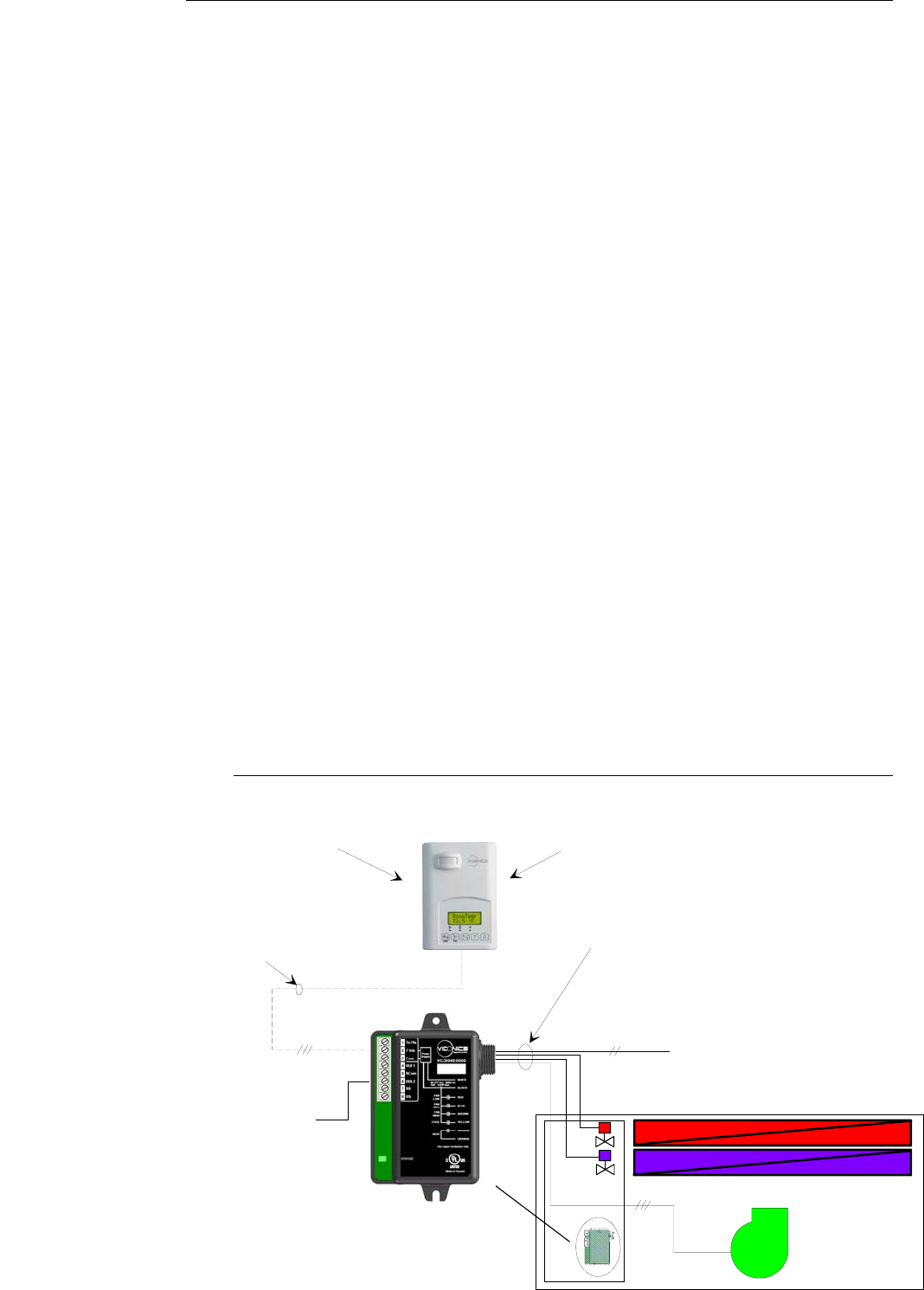
2
Operation overview
The VC3xxxX Series Line Voltage Switching Transformer Relay Pack(s) operate as slave unit(s) under the control of a single
master VTR73xxA Terminal Equipment Controller.
Fan operation can be configured and wired for the following:
o 3 Speed configuration using 3 fan relays ( Low – Med - High )
o 2 Speed configuration using 2 fan relays ( Low - High )
o 3 Speed configuration with Auto fan speed mode using 3 fan relays ( Low – Med - High )
o 2 Speed configuration with Auto fan speed mode using 2 fan relays ( Low - High )
o Single fan speed configuration.
The VTR7300 Controller can be configured for typical 2 or 4 pipe heating / cooling FCU applications.
2 or 4 pipe only operation can be configured and wired for the following:
o Cooling only
o Heating only
o Cooling / Heating with network or local auto changeover
2 or 4 pipe only with electric reheat can be configured and wired for the following:
o Cooling only
o Heating only
o Cooling / Heating with network or local auto changeover
o On-Off electric reheat only
o Cooling with On-Off or modulating Vdc pulsed electric reheat ( model dependent )
o Heating with On-Off or modulating Vdc pulsed electric reheat ( model dependent )
o Cooling / Heating with network or local changeover with On-Off or modulating Vdc pulsed electric reheat (
model dependent )
The VC3xxxX Relay Pack supplies power to the wall VTR73xxA Terminal Equipment Controller.
The VTR73xxA Controller operates the VC3xxxX Relay Pack(s) via a simple communication bus.
A maximum of 10 VC3xxxX Relay Pack can be used under a single VTR73xxA Terminal Equipment Controller.
3 wires minimum are required between the VTR73xxA Controller and the first VR7300 Relay Pack.
The 3 wire functions are as follow:
o 1 Tx / Rx Communication
o 2 Power Hot 7.0 Vdc 4 Watts maximum ( required for the VTR73xxA Controller power )
o 3 Power common
Commands for fan speed and valve operation are issued from the VTR73xxA Terminal Equipment Controller to the
VC3xxxX Relay Pack(s)
Typical one to one set-up
Existing or New Field VTR7300 Wires
3 minimum required 14-22 Ga
Solid or Stranded
H
C
High Voltage in cabinet wiring
- Line powered 90 to 277 Vac
- Line switching of fan & valves 90 to 277 Vac
- Isolated heating output for electric reheat
Line Voltage Power
Line Voltage Valves
- 2 pipes or 4 pipes applications
- Isolated line switching for electric reheat
Line Voltage Fan
- Configurable
- Up to 3 speed
fan control
- Auto fan speed
Local Inputs at VTR7300 Controller
Special optional local function(s):
- Remote motion detector(s)
- Window contacts
- Occupancy card holder
Model Dependent
Optional FCU Monitoring Inputs
- Service or Filter alarms
- Supply air sensor
- Return air sensor
- Changeover sensor or contact
Existing or New Communication Field Wires
- BACnet MS-TP
- LON TP-FT 10
- Wireless ( No wires )

3
Configurable BI, RBI, UI, RUI inputs overview
BI1, Binary input #1 can be configured for the following
functions:
1. (None): No function will be associated with the input
2. (Rem NSB): remote NSB timer clock input. The
scheduling will now be set as per the binary input. It
provides low cost setback operation via a dry contact
• Contact opened = Occupied
• Contact closed = Unoccupied
3. (Motion NO) and (Motion NC): Advanced PIR
occupancy functions using a Normally Open (NO) or
Normally Closed (NC) remote PIR motion sensor.
Occupancy mode is now set as per applied PIR
function and configuration. Application information and
examples, are available on document: APP-PIR-Guide-
Exx. This document will provide the installers and
system designers with detailed examples on
applications, parameter configuration information,
sequence of operation, troubleshooting and diagnostic
help required for the proper usage of the PIR accessory
covers
4. (Window) EMS: Forces the system to disable any
current heating or cooling action by the Terminal
Equipment Controller. The mode stays the same and
the current setpoints are the same Occupied setpoints.
Only the outputs are disabled. There is a Door/Window
alarm displayed on the Terminal Equipment Controller
to indicate to the local tenant that the door/window
needs to be closed for cooling or heating to resume.
Use NC contact.
• Contact opened = System disabled with local
Window alarm
• Contact closed = System enabled
BI2, Binary input #2 can be configured for the following
functions:
1. (None): No function will be associated with the input
2. (Door Dry) Door contact & Motion detector: This
configuration is only functional if binary input #1 is set
to Motion NO or Motion NC or a PIR accessory
cover is used.
With this sequence enabled, the occupancy is now
dictated through those 2 inputs. Any motion detected
will set the zone to occupied status. The zone will
remain permanently in occupied mode until the door
contact switch opens momentarily. The Terminal
Equipment Controller will then go in stand-by mode. If
more movements are detected, the occupied mode will
resume. While the door is opened, any movements
detected by the remote PIR sensor or the PIR
accessory cover will be ignored. Use a Normally Closed
contact-switching device.
• Contact opened = Door opened
• Contact closed = Door closed
RUI1, Remote universal input #1 on VC3xxxX can be
configured for the following functions:
3. (Filter): a backlit flashing Filter alarm will be displayed
on the Terminal Equipment Controller LCD screen
when the input is energized. It can be tied to a
differential pressure switch that monitor filters
• Contact opened = No alarm
• Contact closed = Alarm displayed
4. (Service): a backlit flashing Service alarm will be
displayed on the Terminal Equipment Controller LCD
screen when the input is energized. It can be tied in to
the AC unit control card, which provides an alarm in
case of malfunction.
• Contact opened = No alarm
• Contact closed = Alarm displayed
3. (COC/NH) Change over dry contact. Normally Heat:
Used for hot / cold water change over switching in 2
pipe systems.
• Contact closed = Cold water present
• Contact opened = Hot water present
Only used and valid if system is setup as 2 pipes.
Parameter ( Pipe No ) set as 2 pipes.
4. (COC/NC) Change over dry contact. Normally Cool:
Used for hot / cold water or air change over switching in
2 pipe systems.
• Contact closed = Hot water present
• Contact opened = Cold water present
Only used and valid if system is setup as 2 pipes.
Parameter ( Pipe No ) set as 2 pipes.
5. (COS) Change over analog sensor: Used for hot /
cold water or air change over switching in 2 pipe
systems.
Only used and valid if system is setup as 2 pipes.
Parameter ( Pipe No ) set as 2 pipes.
• If temperature is > 77 °F = Hot water present
• If temperature is < 75 °F = Cold water present
RBI2, Remote binary input #2 on VC3xxxX can be
configured for the following functions:
1. (Filter): a backlit flashing Filter alarm will be displayed
on the Terminal Equipment Controller LCD screen
when the input is energized. It can be tied to a
differential pressure switch that monitor filters
• Contact opened = No alarm
• Contact closed = Alarm displayed
2. (Service): a backlit flashing Service alarm will be
displayed on the Terminal Equipment Controller LCD
screen when the input is energized. It can be tied in to
the AC unit control card, which provides an alarm in
case of malfunction.
• Contact opened = No alarm
• Contact closed = Alarm displayed
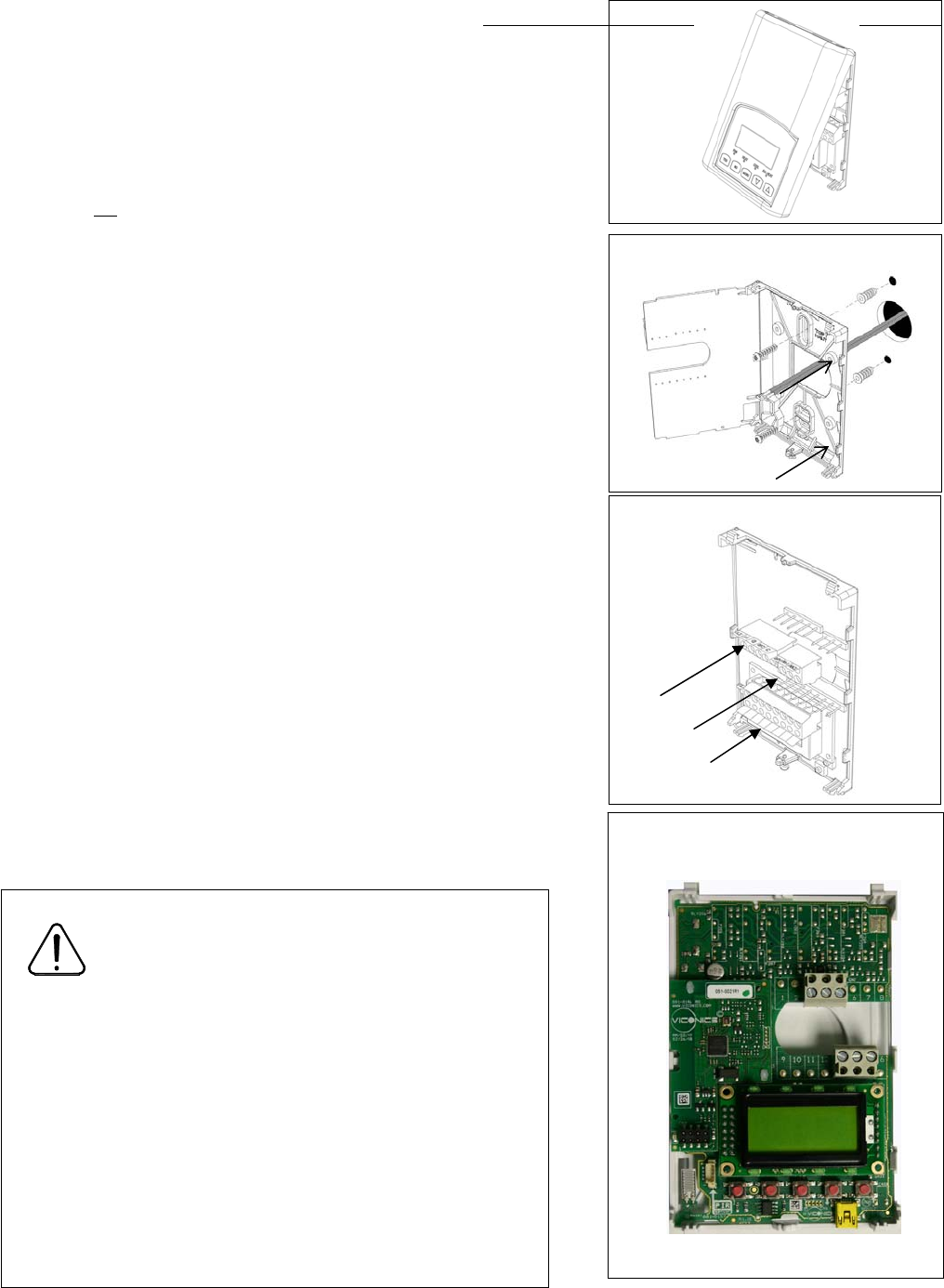
4
VTR73xxA Terminal Equipment Controller Installation
Remove security screw on the bottom of Terminal Equipment Controller cover.
• Open up by pulling on the bottom side of Terminal Equipment Controller.
• Remove Assembly and remove wiring terminals from sticker. (Fig. 3)
• Please note the FCC ID and IC label installed in the cover upon removal
of cover for the wireless products.
A) Location:
1. Should not be installed on an outside wall.
2. Must be installed away from any heat source.
3. Should not be installed near an air discharge grill.
4. Should not be affected by direct sun radiation.
5. Nothing must restrain vertical air circulation to the Terminal Equipment
Controller.
B) Installation:
1. Swing open the Terminal Equipment Controller PCB to the left by
pressing the PCB locking tabs. (Fig. 4)
2. Pull out cables 6” out of the wall.
3. Wall surface must be flat and clean.
4. Insert cable in the central hole of the base.
5. Align the base and mark the location of the two mounting holes on the
wall. Install proper side of base up.
6. Install anchors in the wall.
7. Insert screws in mounting holes on each side of the base. (Fig. 4)
8. Gently swing back the circuit board on the base and push on it until the
tabs lock it.
9. 1Strip each wire 1/4 inch.
10. Insert each wire according to wiring diagram.
11. Gently push back into hole excess wring (Fig. 5)
12. Re-Install wiring terminals in correct location. (Fig. 5)
13. Reinstall the cover (top side first) and gently push back extra wire length
into the hole in the wall.
14. Install security screw.
• If replacing an old Terminal Equipment Controller, label the
wires before removal of the old Terminal Equipment
Controller.
• Electronic controls are static sensitive devices. Discharge
yourself properly before manipulation and installing the
Terminal Equipment Controller.
• Short circuit or wrong wiring may permanently damage the
Terminal Equipment Controller or the equipment.
• All VTR73xxA series Terminal Equipment Controllers are to
be used only as operating controls. Whenever a control
failure could lead to personal injury and/or loss of property, it
becomes the responsibility of the user to add safety devices
and/or alarm system to protect against such catastrophic
failures.
Location of PCB retaining tabs
Re-install terminal blocks
Thermostat assembly
(VTR7350F5000W shown)
Fig.3
Fig.5
Fig.4
Fig.6
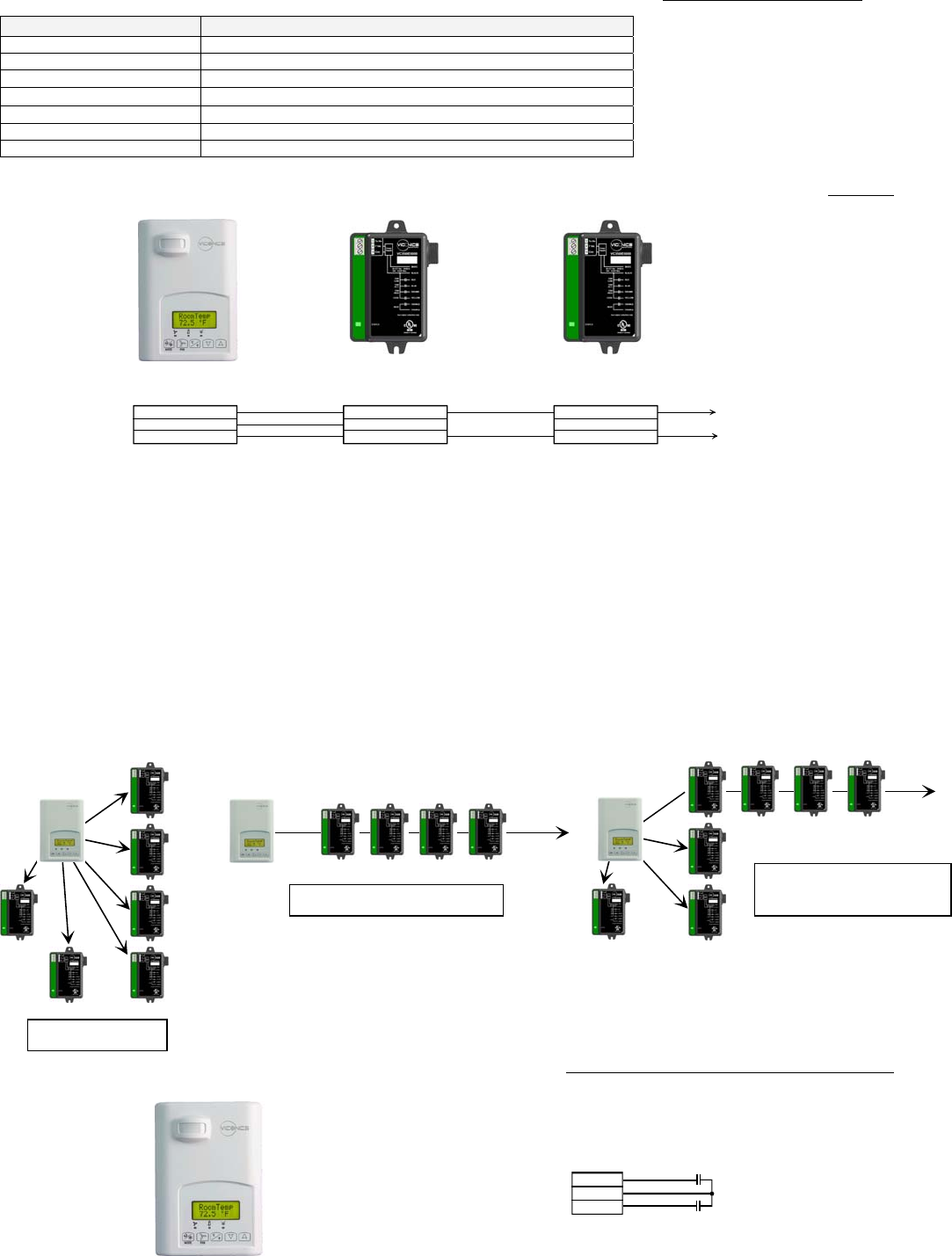
5
VTR73xxA Terminal Equipment Controller Terminal Identification and Function
Terminal Identification All VTR73xxA5x00(X) Terminal Equipment Controller
Terminal 3 Tx – Rx Communication
Terminal 4 Power Hot 7.0 Vdc
Terminal 5 Power Common
Terminal 13 BI 1 ( Configurable )
Terminal 14 Scom
Terminal 15 BI 2 ( Configurable )
VTR73xxA Terminal Equipment Controller Power & Communication Wiring to VC3xxxX Relay Pack
3 - Tx / Rx
4 - 7 Vdc Power Hot
5 - Power Common
To other VC3xxxX
Relay Pack
VC3504E
Relay Pack VC3300E
Relay Pack
VTR73xxA
Terminal Controller
1 - Tx / Rx
2 - 7 Vdc Power Hot
3 - Power Common
1 - Tx / Rx
2 - 7 Vdc Power Hot
3 - Power Common
Only ONE VC3xxxX Relay Pack with remote monitoring inputs can be used under a single VTR73xxA Controller. All other slave units
must me either VC3xxxX Relay Pack(s) WITHOUT remote inputs. A maximum of 10 VC3xxxX Relay Packs can be used for a single
VTR73xxA Terminal Equipment Controller.
From the VTR73xxA Terminal Equipment Controller to the first VC3xxxX Relay Pack
o Existing or new field wires
o 3 minimum required 14-22 Ga Solid or Stranded. Shield not necessary.
From the first VC3xxxX Relay Pack connected to the controller to all other VC3xxxX Relay Pack(s)
o Existing or new field wires
o 2 minimum required 14-22 Ga Solid or Stranded. Shield not necessary.
o Connect only 1 Power Common & 2 Tx-Rx Communication
The VTR7300 to VC3000 Transformer Relay Pack can use ANY network wiring topology as either required, being more
practical or based on availability and topology of existing wires.
Wiring of Local Inputs to VTR73xxA Terminal Equipment Controller
V
TR73xxA
Terminal Controller
13 - BI 1
14 - Scom
15 - BI 2
Local BI 1 Input by configuration:
- None ( monitoring only
- Remote motion detector: Motion NO or Motion
C
- Remote Night Setback:
- Window contact: Window
Local BI 2 Input by configuration:
- None ( m onito ri ng only
)
- Door contact: DoorDry
Dais
y
Chained To
p
olo
gy
Sta
r
To
p
olo
gy
Mixed Daisy Chained &
Start Topology
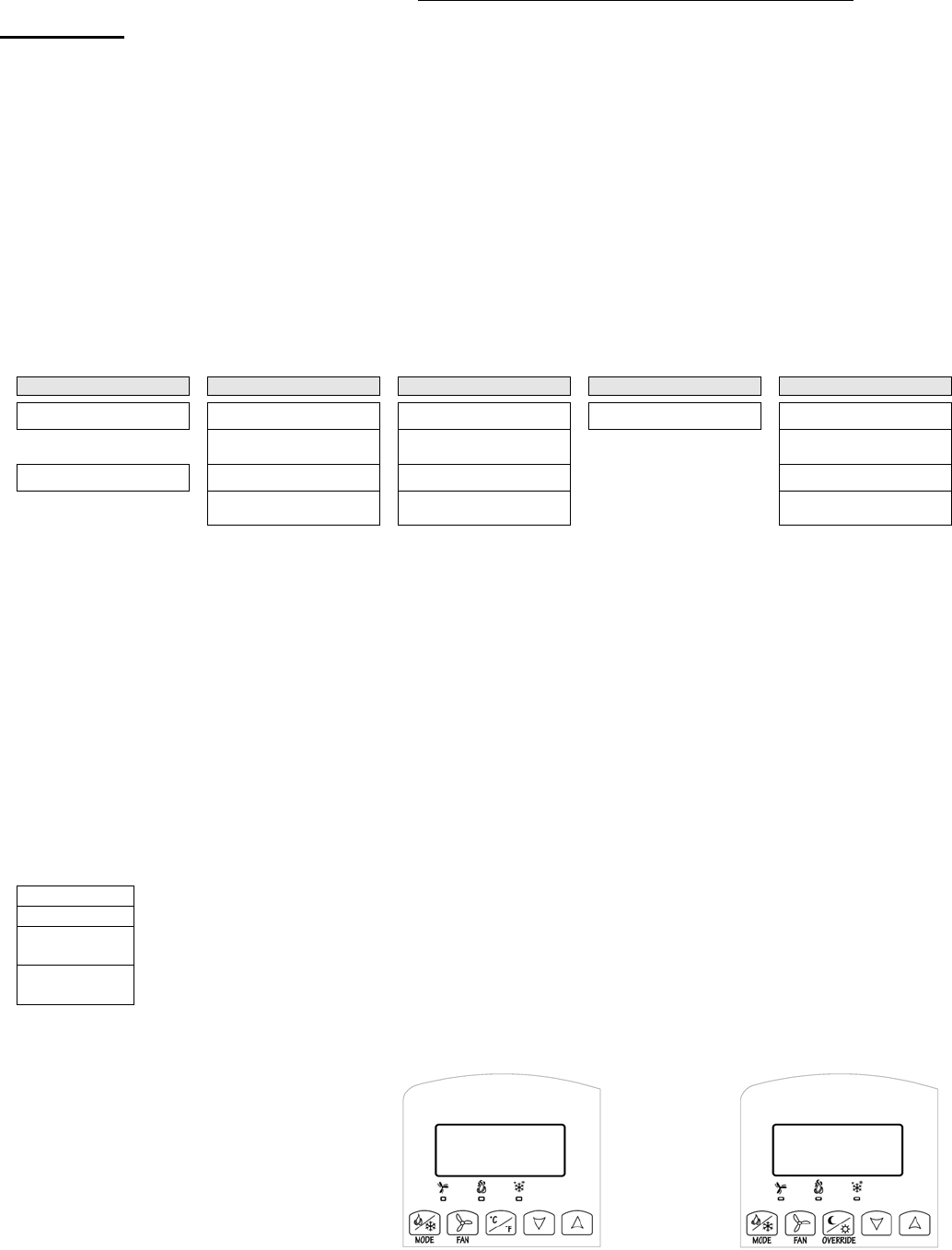
6
Programming and status display instructions
Status display
The VTR73xxA Terminal Equipment Controller features a two-line, eight-character display. There is a low-level backlight
level that is always active and can only be seen at night.
When left unattended, the Terminal Equipment Controller has an auto scrolling display that shows the actual status of
the system. There is an option in the configuration menu to lockout the scrolling display and to only present the room
temperature and conditional outdoor temperature to the user. With this option enabled, no local status is given of mode,
occupancy and relative humidity.
Each item is scrolled one by one with the back lighting in low level mode. Pressing any key will cause the back light to
come on to high level. When left unattended for 10 seconds after changes are made, the display will resume automatic
status display scrolling.
To turn on the back light to high level, press any key on the front panel. The back lit display will return to low level when
the Terminal Equipment Controller is left unattended for 45 seconds
Sequence of auto-scroll status display:
Room & Humidity System Mode Schedule Status Outdoor Temperature Alarms
x.x °C or °F Sys mode Occupied Outdoor Service
XX % RH Auto x.x °C or°F
If humidity display
enabled Sys mode
Cool Stand-By
Network value only Filter
RoomTemp
x.x °C or °F Sys mode
heat Unoccup
Window
If humidity display is not
enabled Sys mode
off Override
Low Batt
% RH display is conditional to:
(Humidity display is model and configuration dependent)
• Model with RH sensor built in
• Display function can be enabled with RH display parameter. Displayed range is 10 to 90 % RH
Outdoor air temperature
• Display is only enabled when outdoor air temperature network variable is received.
Occupancy Status
• Occupied, Stand-By, Unoccupied and Override status are displayed on the scrolling display.
Alarms
• If alarms are detected, they will automatically be displayed at the end of the status display scroll.
• During an alarm message display, the backlit screen will light up at the same time as the message and shut off
during the rest of the status display.
• Two alarms maximum can appear at any given time. The priority for the alarms is as follows:
Service Indicates that there is a service alarm as per one of the programmable binary input ( BI2 )
Filter Indicates that the filters are dirty as per one of the programmable binary input ( BI2 )
Window Indicates that the outside window or door is opened and that the Terminal Equipment Controller has
cancelled any cooling or heating action ( BI1 )
Low Batt Indicates that attached wireless switching devices ( Door or window contact ) have a low battery condition.
Only functional when used with a wireless communication adapter
Three status LED’s on the Terminal Equipment Controller cover are used to indicate the status of the fan ( any speed ), a call for
heat, or a call for cooling.
Fan coil models
• When any of the fan speeds are ON,
the FAN LED will illuminate.
• When heating & reheat is ON,
the HEAT LED will illuminate.
• When cooling is ON,
the COOL LED will illuminate. Fig.11 – Hotel models °C/°F Fig. 12 Commercial models with Override
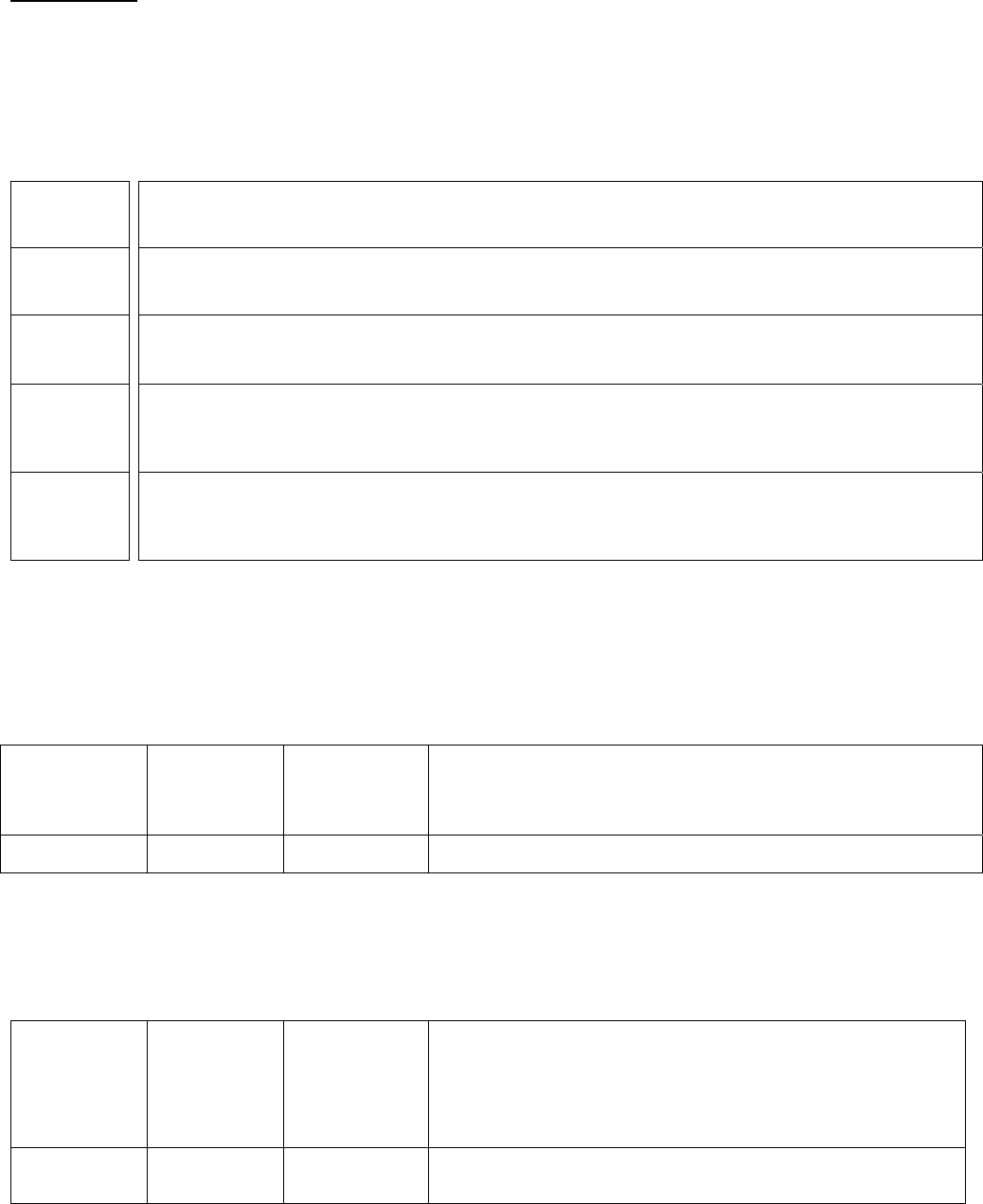
7
User interface
• Unoccupied mode Override
An Override can be made on commercial models during an Unoccupied period. If the Override option is enabled in the
lockout configuration pressing the middle override button will resume occupied setpoints for a time specified by
parameter ToccTime
• Local Keypad interface
System Is used to toggle between the different system mode available as per sequence and menu selected
Pressing repetitively the button will toggle between all the available modes
Available menus are dependent on selected sequence of operation
Fan Is used to toggle between the different fan mode available as per sequence and menu selected
Pressing repetitively the button will toggle between all the available modes
Available menus are dependent on selected sequence of operation and menu selected for Fan
°C/°F
Override
Middle key is
• °C / °F for Hotel models
• Override for commercial models
Down
Adjust the setpoints down
In cooling mode only the cooling setpoint displayed,
In heating mode only the heating setpoint displayed
In auto mode, (See below)
Up
Adjust the setpoints up
In cooling mode only the cooling setpoint displayed,
In heating mode only the heating setpoint displayed
In auto mode, (See below)
• Any setpoint change can be permanent or temporary based on configuration parameter (Setpoint Type)
• Any setpoint written through the network, will be permanent and cancel any active temporary setpoints
• Lockouts of access to certain functions is made with configuration parameter (lockout)
• Local Setpoint Adjustment when “Stp Func” = Dual Stp ( Dual Occupied Setpoints Adjustment )
Occupied setpoint adjustments
Cooling mode Heating mode Off mode
Auto Mode
• Setpoint presented to user is the setpoint from the last action taken by the
Terminal Equipment Controller or the one currently in use.
• If the other setpoint is the one desired, then the MODE button is used to
toggle between the current displayed one and the other.
Cool XX.X °F or
°C Heat XX.X °F or
°C No access to
setpoint Cool XX.X °F or °C or Heat XX.X °F or °C
Toggle to ( Heat or Cool )with MODE button
• Heat/Cool setpoint toggle with MODE button to be active only in AUTO mode.
• If cooling, heating or off mode is active, function is disabled
• Local Setpoint Adjustment when “Stp Func” = AttchStp (Single Occupied SetpointAdjustment )
Occupied setpoint adjustments
Cooling mode Heating mode Off mode
Auto Mode
• Setpoint presented to user is the setpoint from the last action taken by
the Terminal Equipment Controller or the one currently in use.
• Both heating and cooling setpoint are changed simultaneously while
respecting the minimum configured deadband
• If the other setpoint is the one desired, then the MODE button is used to
toggle between the current displayed one and the other.
Cool XX.X
°F or °C Heat XX.X
°F or °C No access to
setpoint
Cool XX.X °F or °C and Heat XX.X °F or °C
Both heating & cooling setpoints are change simultaneously
Toggle to ( Heat or Cool )with MODE button
• Unoccupied and Stand-By setpoints adjustments
Setting the stand-by and unoccupied setpoints is done through the network or through configuration setup only.
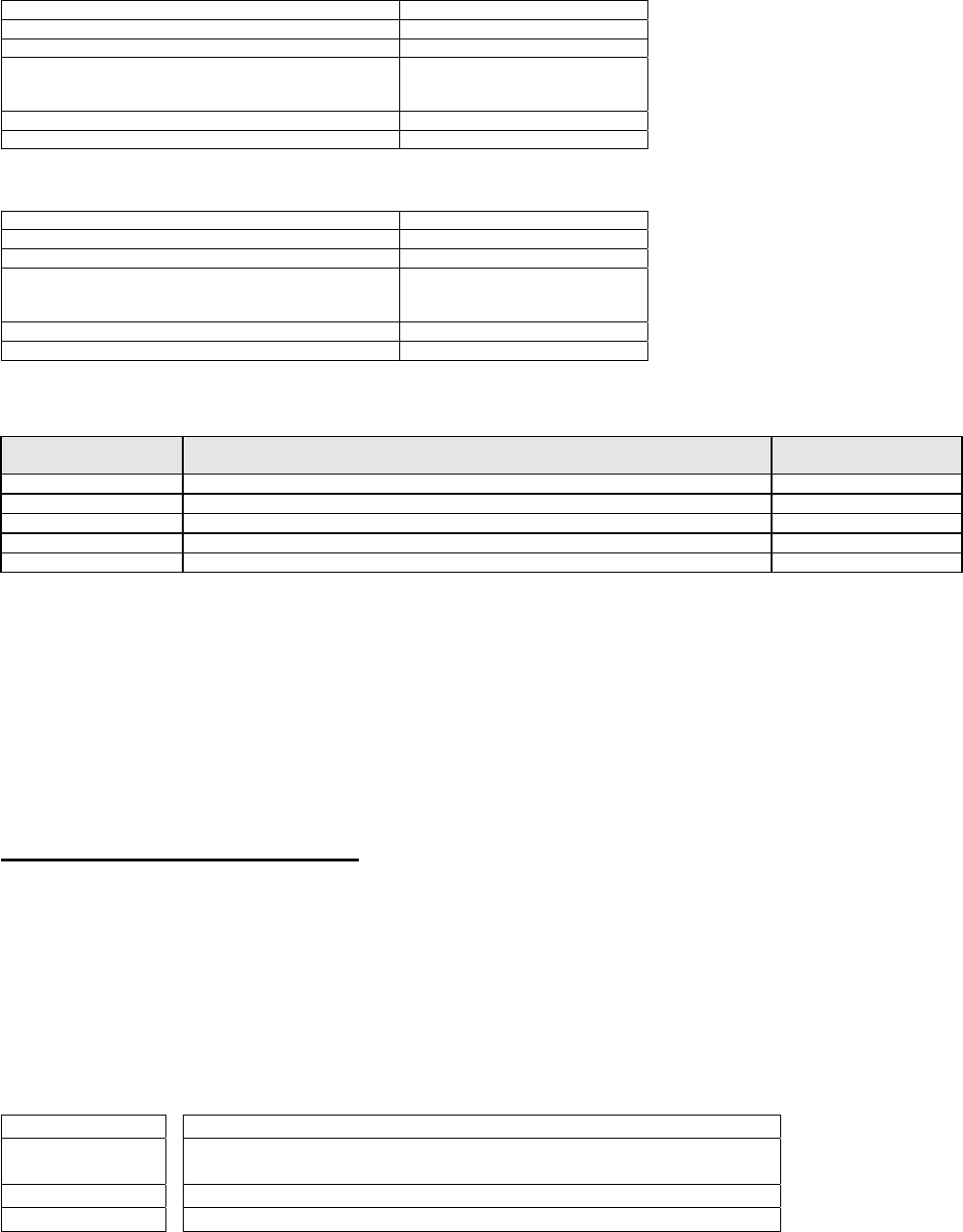
8
• Mode button menu sequence.
- Modes presented to the user are dependent on sequence of operation selected
- Default mode is in bold when sequence of operation parameter is changed
AutoMode set to On = Auto system mode active.
Sequence selected Mode Menu
0 = Cooling Only Off - Cool
1 = Heating Only Off - Heat
2 =
Cooling / Heating
Cooling With Electric Reheat
Off – Auto – Heat – Cool
3 = Heating With Electric Reheat Off - Heat
4 = Electric Reheat Only Off – Heat
AutoMode set to Off = Auto system mode NOT active.
Sequence selected Mode Menu
0 = Cooling Only Off - Cool
1 = Heating Only Off - Heat
2 =
Cooling / Heating
Cooling With Electric Reheat
Off – Heat – Cool
3 = Heating With Electric Reheat Off - Heat
4 = Electric Reheat Only Off – Heat
• Available fan button menu sequences.
Fan button menu
configuration Menu presented are dependent on model used
and sequence of operation selected Default value when
sequence toggled
0 Low-Med-High 3 Speed configuration using 3 fan relays ( L-M-H ) High
1 Low-High 2 Speed configuration using 2 fan relays ( L-H ) High
2 Low-Med-High-Auto 3 Speed configuration with Auto fan speed mode using 3 fan relays ( L-M-H ) High
3 Low-High-Auto 2 Speed configuration with Auto fan speed mode using 2 fan relays ( L-H ) High
4 On-Auto Single Speed configuration. Auto is for Fan on demand / On is On all the time Auto
Auto speed fan mode is also offered in heating mode applications; it will not however have any effect on
dehumidification. It will be strictly for noise comfort issues
Auto Speed Fan Mode operation for sequences 2 and 3 is dependent on Auto Fan parameter. When Auto Fan is set to:
• AS ( Default ) = Auto Speed during occupied periods. Fan is always on during occupied periods. Low,
medium and high speeds operate on temperature offset from setpoint.
• AS AD = Auto Speed / Auto Demand during occupied periods.
- Medium and high speeds operate on temperature offset from setpoint.
- Low speed operates on demand and will shut down when no demand is present
Installer configuration parameter menu
Configuration can be done through the network or locally at the Terminal Equipment Controller.
• To enter configuration, press and hold the middle button (°C/°F or Override) for 8 seconds
• If a password lockout is active, “Password” is prompted. Enter password value using the “up” and “down” arrows
and press the middle button again to gain access to all configuration properties of the Terminal Equipment
Controller. A wrong password entered will prevent local access to the configuration menu.
• Press the same middle button repetitively to scroll between all the available parameters
• Use the up and down key to change the parameter to the desired value.
• To acknowledge and save the new value, press the middle button again.
• The next listed parameter is now displayed
Configuration interface
Fan Re-starts the configuration parameter list at the beginning
°C/°F
Override Enters the configuration mode. Press and hold for 8 seconds
Pressing repetitively will scroll all available parameters one by one
Down Adjust / rotate parameter value down
Up Adjust / rotate parameter value up

9
Configuration parameters
Default value Significance and adjustments
PswrdSet
Configuration parameters menu
access password
Default value = 0
Range is: 0 to 1000
This parameter sets a protective access password to prevent unauthorized access
to the configuration menu parameters. A default value of “0” will not prompt a
password or lock the access to the configuration menu.
Range is: 0 to 1000
Com Addr
Terminal Equipment Controller
networking address
Default value = 254
Range is: 0 to 254
Conditional parameter to BACnet MS-TP models VTR73xxX5x00B
Conditional parameter to Wireless models VTR73xxX5x00W
• For BACnet MS-TP models valid range to use is from 1 to 127. Default value of
254 disables BACnet communication for the Terminal Equipment Controller.
• For wireless models valid range is 0 to 254 with a maximum of 30 Terminal
Equipment Controller per VWG
PAN ID
Personal Area Network
Identification
Default value = 0
Range is: 0 to 1000
Conditional parameter to Wireless models VTR73xxX5x00W
This parameter will only appear when a wireless network adapter is present. If the
Terminal Equipment Controller is installed as a stand-alone unit or with a BACnet
or Echelon adapter, this parameter will not be used or displayed
This parameter (Personal Area Network Identification) is used to link specific
Terminal Equipment Controllers to a single specific Viconics wireless gateway (
VWG ). For every Terminal Equipment Controller reporting to a gateway (
maximum of 30 Terminal Equipment Controllers per gateway ), be sure you set the
SAME PAN ID value both at the gateway and the Terminal Equipment
Controller(s).
The default value of 0 is NOT a valid PAN ID.
The valid range of available PAN ID is from:
- PAN ID 1 in association with Channel 26 is reserved for remote wireless
switching device configuration only
- 2 to 500 for applications using the VWG or a Jace with the wireless stat
driver
- 501 to 1000 for stand-alone applications where no VWG or Jace with the
wireless stat driver is used. Stand-Alone applications
Channel
Channel selection
Default value = 10
Range is: 10 to 26
Conditional parameter to Wireless models VTR73xxX5x00W
This parameter will only appear when a wireless network adapter is present. If the
Terminal Equipment Controller is installed as a stand-alone unit or with a BACnet
or Echelon adapter, this parameter will not be used or displayed
This parameter (Channel) is used to link specific Terminal Equipment Controllers to
specific Viconics wireless gateway(s) ( VWG ) For every Terminal Equipment
Controller reporting to a gateway ( maximum of 30 Terminal Equipment Controllers
per gateway ), be sure you set the SAME channel value both at the gateway and
the Terminal Equipment Controller(s).
Viconics recommends using only the 2 last channels ( 25-2575MHz and 26-
2580MHz )
The default value of 10 is NOT a valid channel. The valid range of available
channel is from 11 to 26
PAN ID 1 in association with Channel 26 is reserved for remote wireless switching
device configuration only

10
Get From
Terminal Equipment Controller
Get From another device
configuration utility
Default value = 0
Range is: 0 to 254
Conditional parameter to Wireless models VTR73xxX5x00W
Entering a MAC address enables an automatic routine that automatically fetches
all the required configuration property of the current device from another one
already configured to the same required property values.
If another value than the default value of 255 is entered, user will then be prompted
to exit the Configuration Menu thus leaving all other parameter configuration to be
copied from the referenced controller MAC address.
Ex.: If you are currently configuring MAC12 and that the settings match exactly
the settings of ZN MAC5, then enter 5 as the current parameter value.
• If the process is successful and all required configuration properties have been
copied, the value will revert back to 255
• If the process is NOT successful and all required configuration properties have
NOT been copied ( either the reference device is NOT the same model number
or is offline or does not exists ) the value will revert back to 254 to indicate the
failure of the process
Leaving the Get From parameter to 255 means that every configuration
parameters will be set manually.
BI 1
Binary input no.1 configuration
Default value = None
(None): No function will be associated with the input. Input can be used for remote
network monitoring.
(Rem NSB): remote NSB timer clock input. The scheduling will now be set as per
the binary input. It provides low cost setback operation via a dry contact
• Contact opened = Occupied
• Contact closed = Unoccupied
(Motion NO) or (Motion NC): Advanced PIR occupancy functions using a
Normally Open (NO) or Normally Closed (NC) remote PIR motion sensor.
Occupancy mode is now set as per applied PIR function and configuration.
Application information and examples are available on document: APP-PIR-Guide-
Exx. This document will provide the installers and system designers with detailed
examples on applications, parameter configuration information, sequence of
operation, troubleshooting and diagnostic help required for the proper usage of the
PIR accessory covers
(Window) EMS: Forces the system to disable any current heating or cooling action
by the Terminal Equipment Controller. The mode stays the same and the current
setpoints are the same Occupied setpoints. Only the outputs are disabled. There is
a Door/Window alarm displayed on the Terminal Equipment Controller to indicate
to the local tenant that the door/window needs to be closed for cooling or heating to
resume.
• Contact opened = Window Opened
• Contact closed = Window Closed
BI 2
Binary input no.2 configuration
Default value = None
(None): No function will be associated with the input. Input can be used for remote
network monitoring.
(Door Dry) Door contact & Motion detector: This configuration is only functional
if binary input #1 is set to Motion NO or Motion NC or a PIR accessory cover is
used.
With this sequence enabled, the occupancy is now dictated through those 2 inputs.
Any motion detected will set the zone to occupied status. The zone will remain
permanently in occupied mode until the door contact switch opens momentarily.
The Terminal Equipment Controller will then go in stand-by mode. If more
movements are detected, the occupied mode will resume. While the door is
opened, any movements detected by the remote PIR sensor or the PIR accessory
cover will be ignored. Use a Normally Closed contact switching device.
• Contact opened = Door opened
• Contact closed = Door closed

11
RUI 1
Remote Universal input no.1
configuration
Default value = None
(None): No function will be associated with the input. Input can be used for remote
network monitoring.
(COC/NH) Change over dry contact. Normally Heat: Used for hot / cold water or
air change over switching in 2 pipe systems.
• Contact closed = Cold water or air present
• Contact opened = Hot water or air present
Only used and valid if system is setup as 2 pipes. Parameter ( Pipe No ) set as 2
pipes.
(COC/NC) Change over dry contact. Normally Cool: Used for hot / cold water or
air change over switching in 2 pipe systems.
• Contact closed = Hot water present
• Contact opened = Cold water present
Only used and valid if system is setup as 2 pipes. Parameter (Pipe No ) set as 2
pipes.
(COS) Change over analog sensor: Used for hot / cold water or air change over
switching in 2 pipe systems.
Only used and valid if system is setup as 2 pipes. Parameter (Pipe No ) set as 2
pipes.
• If water temperature is > 78 °F = Hot water present
• If water temperature is < 75 °F = Cold water present
(Filter): a backlit flashing Filter alarm will be displayed on the Terminal Equipment
Controller LCD screen when the input is energized. It can be tied to a differential
pressure switch that monitor filters
• Contact opened = No alarm
• Contact closed = Alarm displayed
(Service): a backlit flashing Service alarm will be displayed on the Terminal
Equipment Controller LCD screen when the input is energized. It can be tied in to
the AC unit control card, which provides an alarm in case of malfunction.
• Contact opened = No alarm
• Contact closed = Alarm displayed
RBI 2
Remote Binary input no.2
configuration
Default value = None
(None): No function will be associated with the input. Input can be used for remote
network monitoring.
(Filter): a backlit flashing Filter alarm will be displayed on the Terminal Equipment
Controller LCD screen when the input is energized. It can be tied to a differential
pressure switch that monitor filters
• Contact opened = No alarm
• Contact closed = Alarm displayed
(Service): a backlit flashing Service alarm will be displayed on the Terminal
Equipment Controller LCD screen when the input is energized. It can be tied in to
the AC unit control card, which provides an alarm in case of malfunction.
• Contact opened = No alarm
• Contact closed = Alarm displayed
MenuScro
Menu scroll
Default value = On = Scroll active
Removes the scrolling display and only present the room temperature/humidity to
the user. With this option enabled, no status is given of mode, schedule and
outdoor temperature.
• On = Scroll active
• Off = Scroll not active
AutoMode
Enables Auto menu for Mode
button
Default value = On
Enables Auto function for the mode button
For sequences 2, 4 & 5 only
• On = Auto active (Off-Cool-Heat-Auto)
• Off = auto not active (Off-Cool-Heat)
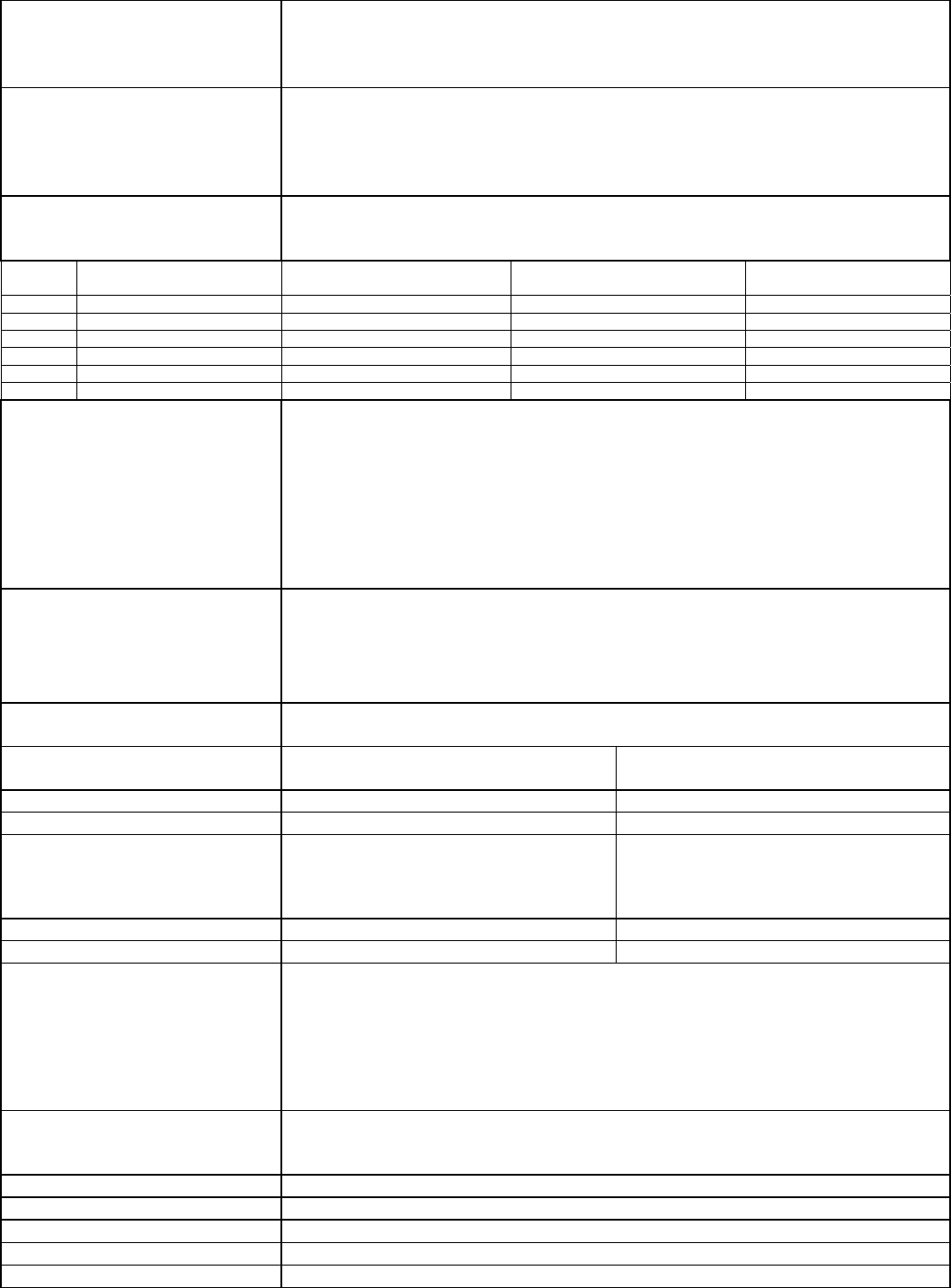
12
C or F
Sets scale of the Terminal
Equipment Controller
Default value = °F
• °F for Fahrenheit scale
• °C for Celsius scale
On hotel models, this sets the default value when the Terminal Equipment
Controller powers up
%RH disp
Local %RH Display
Default value = OFF
Models with Humidity sensor only
Conditional parameter to Humidity models VTR735xX5x00(X)
Enables the display of humidity below the room temperature on the display
• ON = Display %RH
• OFF = No display of %RH
Lockout
Keypad lockout levels
Default value = 0 No lock
Level Occupied temperature
setpoints System mode setting Fan mode setting Unoccupied Override
0 Yes access Yes access Yes access Yes access
1 Yes access Yes access Yes access No access
2 Yes access No access No access Yes access
3 Yes access No access No access No access
4 No access No access No access Yes access
5 No access No access No access No access
PulsedHt
Enable pulsed electric heat
Default Value = Off
Enables Vdc modulating pulsed electric reheat applications used with SSR’s.
Only used with VC340xX Relay Pack models
• Off = Regular On-Off control for VC350xE models
Can be used with 2 pipes & 4 pipes applications
• On = 10 second pulsed time base modulation for VC340xE models
Can only be used with 2 pipes
The VC3400E & VC3404E cannot be used for 4 pipes applications
Pipe No
System type installation
Number of pipes
Default is: 4.0 Pipes
Defines the type of system installed
2.0 Pipes, will limit the number of sequences of operation available from 0 to 2
Will enable heat/cool operation from the same output
4.0 Pipes, can access all the sequences of operation from 0 to 4
Will enable heat/cool operation from different output
SeqOpera Sequence of operation
Default is: Sequence #1 Selects the initial sequence of operation required by the installation type and the
application
System = 2 Pipes
VR7300A, B C & E Models System = 4 Pipes
VR7300A & C Models only
0 = Cooling Only Yes access Yes access
1 = Heating Only Yes access Yes access
2 =
Cooling / Heating
or
Cooling With Electric Reheat
Yes access
Cooling With Electric Reheat
Yes access
Cooling / Heating
3 = Heating With Electric Reheat Yes access No access
4 = Electric Reheat Only Yes access No access
For 2 Pipe output applications, the system access is also limited if RUI 1 is
configured for local changeover COS, COC/NC or COC/NC. The current water
temperature detected by the RUI 1 then limits the system mode available for the
local configuration or network write.
For sequence 2 & 3, set PulsedHt to On to enable pulsed electric reheat
applications with VR7300B & E
Fan Menu
Mode button menu configuration
Default is: Menu #4
Menu presented are dependent on model used and sequence of operation
selected
Auto Mode operation for sequences 2 and 3 is dependent on Auto Fan parameter
0 = Low-Med-High 3 Speed configuration using 3 fan relays ( L-M-H )
1 = Low-High 2 Speed configuration using 2 fan relays ( L-H )
2 = Low-Med-High-Auto 3 Speed configuration with Auto fan speed mode using 3 fan relays ( L-M-H )
3 = Low-High-Auto 2 Speed configuration with Auto fan speed mode using 2 fan relays ( L-H )
4 = On-Auto Single Speed configuration. Auto is for Fan on demand / On is On all the time
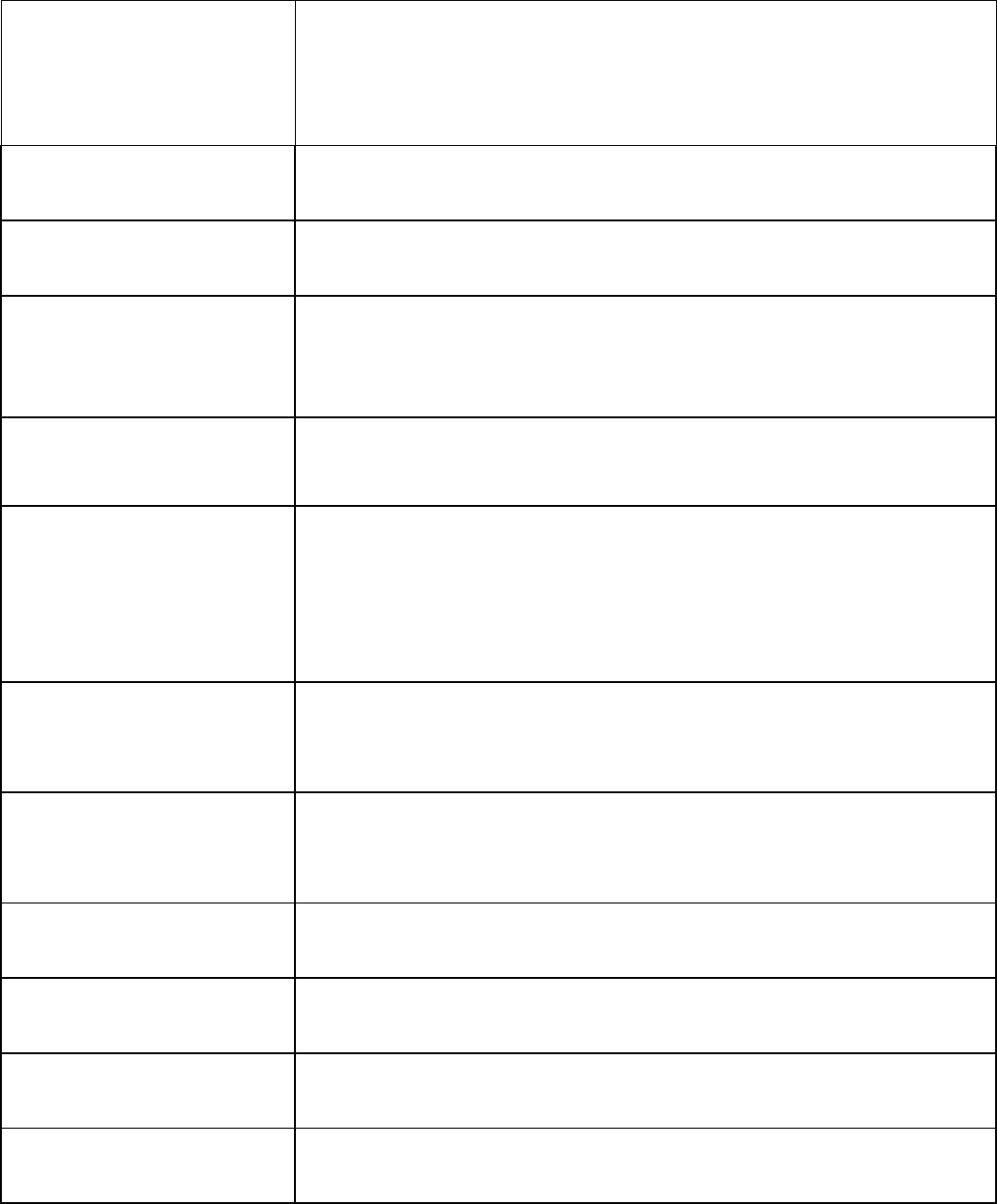
13
DHumiLCK
Dehumidification lockout
Default value: On = Authorized
Conditional parameter to Humidity models VTR735xX5x00(X)
Typically toggled through the network.
This variable enables or disables dehumidification based on central network
requirements from the BAS front end
• On = Dehumidification Authorized
• Off = Dehumidification Not Authorized
%RH set
Dehumidification setpoint
Default is 50 % RH
Conditional parameter to Humidity models VTR735xX5x00(X)
Used only if dehumidification sequence is enabled:
Range is: 30-95% RH
DehuHyst
Dehumidification Hysterisys
Default is 5 % RH
Conditional parameter to Humidity models VTR735xX5x00(X)
Humidity control hysterisys. Used only if dehumidification sequence is enabled:
Range is: 2 to 20% RH
DehuCool
Maximum Dehumidification
Cooling output
Default is 100 %
Conditional parameter to Humidity models VTR735xX5x00(X)
Maximum cooling valve position when dehumidification is enabled. This can be
used to balance smaller reheat loads installed in regards to the capacity of the
cooling coil.
Range is: 20 to 100 %
St-By TM
Stand-by Timer value
Default 0.5 hours
Time delay between the moment where the PIR cover detected the last movement
in the area and the time which the Terminal Equipment Controller stand-by mode
and setpoints become active.
Range is: 0.5 to 24.0 hours in 0.5hr increments
Unocc TM
Unoccupied Timer value
Default 0.0 hours
Time delay between the moment where the Terminal Equipment Controller toggles
to stand-by mode and the time which the Terminal Equipment Controller
unoccupied mode and setpoints become active.
The factory value or 0.0 hours: Setting this parameter to its default value of 0.0
hours disables the unoccupied timer. This prevents the Terminal Equipment
Controller to drift from stand-by mode to unoccupied mode when PIR functions are
used
Range is: 0.0 to 24.0 hours in 0.5hr increments
St-By HT
Stand-by heating setpoint
Default value = 69 °F
The value of this parameter should reside between the occupied and unoccupied
heating setpoints and make sure that the difference between the stand-by and
occupied value can be recovered in a timely fashion when movement is detected
in the zone.
Stand-by heating setpoint range is: 40 to 90 °F ( 4.5 to 32.0 °C )
St-By CL
Stand-by cooling setpoint limit
Default value = 78 °F
The value of this parameter should reside between the occupied and unoccupied
cooling setpoints and make sure that the difference between the stand-by and
occupied value can be recovered in a timely fashion when movement is detected
in the zone.
Stand-by cooling setpoint range is: 54 to 100 °F ( 12.0 to 37.5 °C )
Unocc HT
Unoccupied heating setpoint
Default value = 62 °F
Unoccupied heating setpoint range is:
40 to 90 °F ( 4.5 to 32.0 °C )
Unocc CL
Unoccupied cooling setpoint limit
Default value = 80 °F
Unoccupied cooling setpoint range is:
54 to 100 °F ( 12.0 to 37.5 °C )
heat max
Maximum heating setpoint limit
Default value = 90 °F ( 32 °C )
Maximum occupied & unoccupied heating setpoint adjustment.
Heating setpoint range is:
40 to 90 °F ( 4.5 to 32.0 °C )
cool min
Minimum cooling setpoint limit
Default value = 54 °F ( 12 °C )
Minimum occupied & unoccupied cooling setpoint adjustment.
Cooling setpoint range is:
54 to 100 °F ( 12.0 to 37.5 °C )
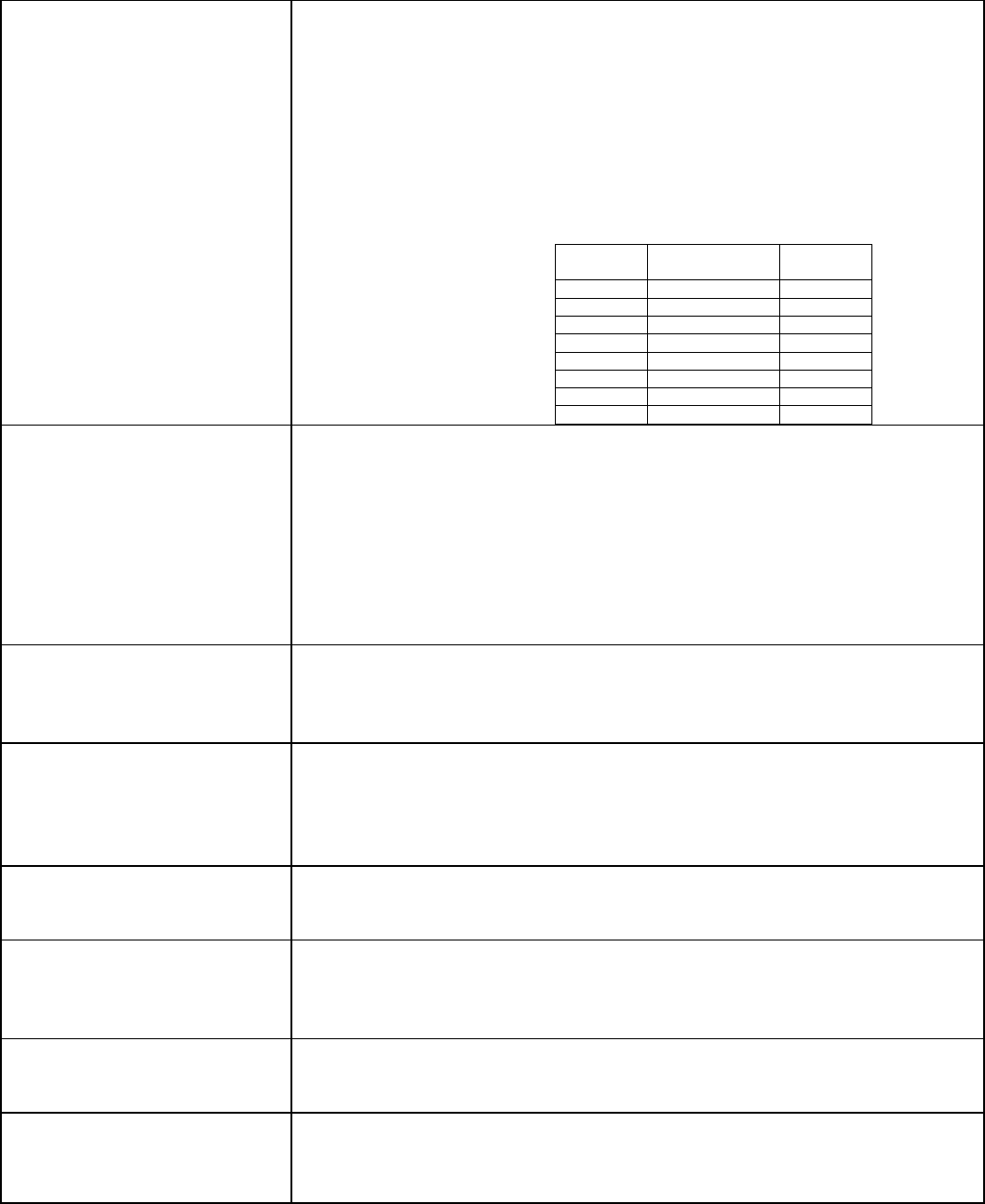
14
Pband
Proportional band setting
Default is : 3
Adjust the proportional band used by the Terminal Equipment Controller PI control
loop.
Warning. Note that the default value of 3.0 °F ( 1.2 °C ) gives satisfactory
operation in most normal installation cases. The use of a superior proportional
band different than the factory one is normally warranted in applications where the
Terminal Equipment Controller location is problematic and leads to unwanted
cycling of the unit. A typical example is a wall mounted unit where the Terminal
Equipment Controller is installed between the return and supply air feeds and is
directly influenced by the supply air stream of the unit.
Value F scale Pband C scale
Pband
3 3 F 1.2 C
4 4 F 1.7 C
5 5 F 2.2 C
6 6 F 2.8 C
7 7 F 3.3 C
8 8 F 3.9 C
9 9 F 5.0 C
10 10 F 5.6 C
Set Type
Temporary setpoint enable
Default is : Permnent
Enables temporary setpoints
feature to any change of
occupied or unoccupied setpoint.
Temporar: (temporary) Local changes to the heating or cooling setpoints by the
user are temporary. They will remain effective for the duration specified by
ToccTime. Setpoints will revert back to their default value after internal timer
ToccTime expires.
To change setpoints permanently, revert to No this variable or write setpoints
through the network. Any setpoints written through the network will be permanent
ones and saved to EEPROM.
Permnent: (permanent) Any change of occupied or unoccupied setpoints through
the keypad by the user are permanent and saved to & EEPROM
SptFunc
Local setpoint settings
Default value = Dual Stp
Set the local setpoint interface for the user
• Dual Stp ( Dual Occupied Setpoints Adjustment )
• AttchStp ( Single Occupied Setpoint Adjustment )
TOccTime
Temporary occupancy time
Default value = 2 hours
Temporary occupancy time with occupied mode setpoints when override function
is enabled
When the Terminal Equipment Controller is in unoccupied mode, function is
enabled with either the menu or UI2 configured as remote override input.
Range is: 0,1, 2, 3, 4, 5, 6, 7, 8, 9, 10, & up to 24 hours
deadband
Minimum deadband
Default value = 2.0 °F ( 1.0 °C )
Minimum deadband value between the heating and cooling setpoints. If modified,
it will be applied only when any of the setpoints are modified.
Range is: 2, 3, 4 or 5 °F, 1.0 °F increments ( 1.0 to 2.5 °C, 0.5 °C increments )
cal RS
Room temperature sensor
calibration
Default value = 0.0 °F or °C
Offset that can be added/subtracted to actual displayed room temperature
Range is: ± 5.0 °F, 1.0 °F increments ( ± 2.5 °C, 0.5 °C increments )
cal RH
Humidity sensor calibration
Default value = 0 %RH
Offset that can be added/subtracted to actual displayed humidity by ± 15.0 %RH.
Range is : ± 15.0 %RH
Auto Fan
Auto Fan Function
Default value: AS
Auto Speed Fan Mode operation for Fan Sequences 2 and 3
AS = Auto Speed during occupied periods. Fan is always on during occupied
periods.
AS AD = Auto Speed / Auto Demand during occupied periods.

15
Cool cph
Cooling output cycles per hour
Default value = 4 C.P.H.
Will set the maximum number cycles per hour under normal control operation. It
represents the maximum number of cycles that the equipment will turn ON and
OFF in one hour.
Note that a higher C.P.H will represent a higher accuracy of control at the expense
of wearing mechanical components faster.
Range is: 3, 4, 5, 6,7 & 8 C.P.H.
Heat cph
Heating output cycles per hour
Default value = 4 C.P.H.
Will set the maximum number cycles per hour under normal control operation. It
represents the maximum number of cycles that the equipment will turn ON and
OFF in one hour.
Note that a higher C.P.H will represent a higher accuracy of control at the expense
of wearing mechanical components faster.
Range is: 3, 4, 5, 6,7 & 8 C.P.H.
CoolNoNc
Normally open or close device
Default value = NC
Set’s the type of valve used for heating
• NC = Valve is normally closed when no power is present
• NO = Valve is normally opened when no power is present
HeatNoNc
Normally open or close device
Default value = NC
Set’s the type of valve used for heating
• NC = Valve is normally closed when no power is present
• NO = Valve is normally opened when no power is present
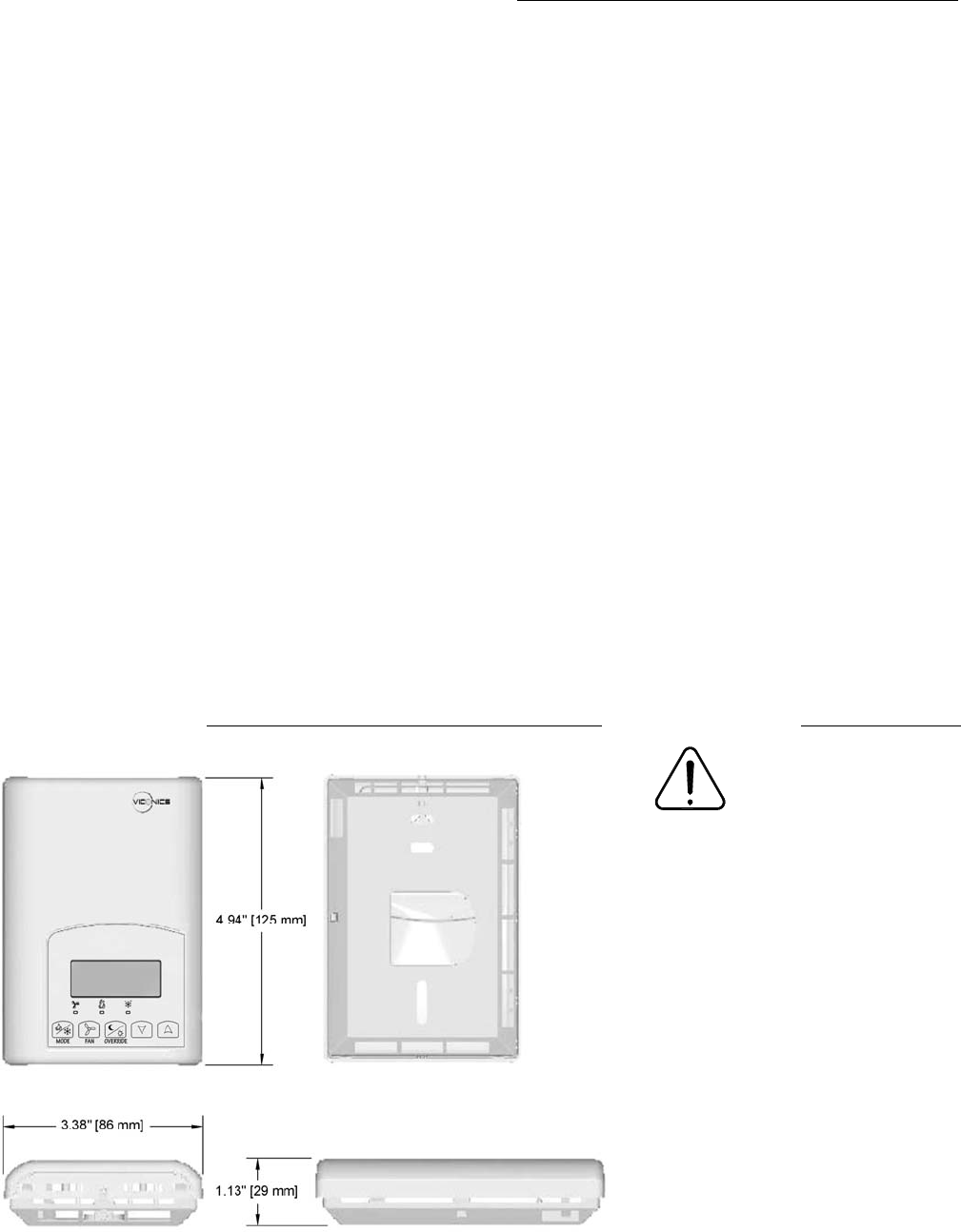
16
VTR73xxA Terminal Equipment Controller Specifications
Terminal Equipment Controller power requirements: 7.0 Vdc +/- 10% 2.4 watts minimum
Operating conditions: 0 °C to 50 °C ( 32 °F to 122 °F )
0% to 95% R.H. non-condensing
Storage conditions: -30 °C to 50 °C ( -22 °F to 122 °F )
0% to 95% R.H. non-condensing
Temperature sensor: Local 10 K NTC thermistor
Temperate sensor resolution: ± 0.1 °C ( ± 0.2 °F )
Temperature control accuracy: ± 0.5 ° C ( ± 0.9 °F ) @ 21 °C ( 70 °F ) typical calibrated
Humidity sensor and calibration: Single point calibrated bulk polymer type sensor
Humidity sensor precision: Reading range from 10-90 % R.H. non-condensing
10 to 20% precision is 10%
20% to 80% precision is 5%
80% to 90% precision is 10%
Humidity sensor stability Less than 1.0 % yearly (typical drift)
Dehumidification setpoint range: 30% to 95% R.H.
Occ, Stand-By and Unocc cooling setpoint range: 12.0 to 37.5 °C ( 54 to 100 °F )
Occ, Stand-By and Unocc heating setpoint range: 4.5 °C to 32 °C ( 40 °F to 90 °F )
Room and outdoor air temperature display range -40 °C to 50 °C ( -40 °F to 122 °F )
Proportional band for room temperature control: Cooling & Heating: Default: 1.8°C ( 3.2°F )
Binary inputs: Dry contact across terminal BI1, BI2 & UI3 to Scom
Wire gauge 14 gauge maximum, 22 gauge recommended
Dimensions: 4.94” x 3.38” x 1.13”
Approximate shipping weight: 0.75 lb ( 0.34 kg )
(PENDING) Agency Approvals all models: UL: UL 873 (US) and CSA C22.2 No. 24 (Canada), File E27734
with CCN XAPX (US) and XAPX7 (Canada)
Industry Canada: ICES-003 (Canada)
(PENDING) Agency Approvals all models FCC: Compliant to CFR 47, Part 15, Subpart B, Class A (US)
CE: EMC Directive 89/336/EEC (Europe Union)
C-Tick: AS/NZS CISPR 22 Compliant (Australia / New Zealand)
Supplier Code Number N10696
(PENDING) Agency Approvals Wireless models FCC: Compliant to: Part 15, Subpart C
THIS DEVICE COMPLIES WITH PART 15 OF THE FCC RULES. OPERATION IS SUBJECT TO THE FOLLOWING TWO
CONDITIONS: (1) THIS DEVICE MAY NOT CAUSE HARMFUL INTERFERENCE, AND (2) THIS DEVICE MUST ACCEPT
ANY INTERFERENCE RECEIVED, INCLUDING INTERFERENCE THAT MAY CAUSE UNDESIRED OPERATION.
Drawing & Dimensions
Fig.13 – Terminal Equipment Controller dimensions
Important Notice
All VTR7300 series
controls are for use as
operating controls only
and are not safety
devices. These instruments have
undergone rigorous tests and
verifications prior to shipment to
ensure proper and reliable operation in
the field. Whenever a control failure
could lead to personal injury and/or
loss of property, it becomes the
responsibility of the user / installer /
electrical system designer to
incorporate safety devices ( such as
relays, flow switch, thermal
protections, etc…) and/or alarm
system to protect the entire system
against such catastrophic failures.
Tampering of the devices or miss
application of the device will void
warranty.